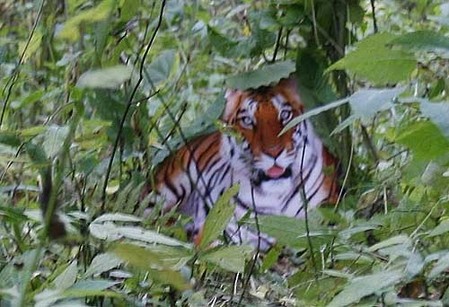XI'AN - The controversial photographs of a rare South China tiger in the wild were allegedly fabricated by farmer Zhou Zhenglong, Shaanxi Provincial government officials said on Sunday.
Zhou, 54, from Zhenping county, claimed to have photographed the tiger with a digital camera on the afternoon of October 3 last year, but he had been arrested on suspicion of fraud. The Provincial Forestry Department had revoked his reward of 20,000 yuan ($2,915).

A purported South China tiger is pictured in this file photo taken by farmer Zhou Zhenglong. [Xinhua]
|
Police have seized an old tiger picture, which he allegedly borrowed from a farmer in another village in September to produce his photos. They also found a wooden model of tiger claw, which Zhou allegedly used to fabricate a South China tiger paw print on snow.
Thirteen local officials have been penalized in connection with the scandal, including Provincial Forestry Department deputy head Zhu Julong and Sun Chengqian, the official in charge of wildlife preservation Wang Wanyun, and media official Guan Ke who were sacked for dereliction of duty.
Li Qian, an official with the wildlife preservation station of the Zhenping county, was also sacked for failing to make a site verification of the photos before producing a verification report.
A police investigation found the photos were shot in the forest of Madaozi, 15 kilometers from the Wencai village of Zhenping county, at an altitude of 2,000 meters, said Bai Shaokang, spokesperson of the Public Security Department of Shaanxi.
"It was a small area with few tall trees, which was not a suitable habitat for a real tiger," he said.
Police also located the trees beside the South China tiger in Zhou's picture and measured them at 0.8 of a centimeter in diameter. Calculations showed the pictured tiger would have been just 27 centimeters long and 35 centimeters wide.
Zhou, who had previously insisted that he "risked his life to take the photos of a real tiger", allegedly said he was influenced by members of a search team, for whom he acted as guide in 2006. They told him that photos of footprints, feces, and fur of South China tigers could earn a reward of thousands of yuan, and if he could find a real tiger in the wild, he could get more than 1 million yuan.
Zhou earned 1,000 yuan acting as a guide for the search team, further fueling his desire for a greater reward.
He asked other villagers to seek tiger pictures for him on the excuse of helping his nephew overcome psychiatric problems. A villager surnamed Peng found such a picture from his neighbor and gave it to Zhou.
Zhou folded the picture around the outline of the tiger, posed it on the grass on the afternoon of Sep. 27, and took several pictures.
Dissatisfied, he found a better spot on October 3 in front of a small tree and produced the controversial photos with a camera borrowed from his brother-in-law.
The Provincial Forestry Department claimed at a press conference that the photos, first published on October 12, were proof the rare tiger still existed in the wild.
But Internet users accused Zhou of making the tiger images with digital software, and local authorities of approving the photos to bolster tourism.
The "paper tiger" saga aroused widespread interest among the public after the appearance of a Lunar New Year commemorative poster with a picture of a tiger that bore a striking resemblance to the one in Zhou's pictures.
This led to strong public demands for official proof of authenticity.
Under pressure, Zhou made a wooden model of tiger claw with help from another villager surnamed Yi.
The embarrassed provincial forestry department apologized in a letter to the public for "inappropriately publicizing the discovery of the wild South China tiger" in February, but made no comment on the photo's authenticity.
The South China tiger, also called the "Amoy" or "Xiamen tiger, " is widely believed to be extinct in the wild. It is thought to be the progenitor of all modern tigers, according to the World Wildlife Fund.
It is considered critically endangered, mainly due to a loss of habitat. By 1996, its population numbered only 30 to 80, according to the World Conservation Union's Red List of threatened species.
"The provincial government will draw a lesson from this scandal to reflect on the problems in our work," said Xue Chunhua, spokesperson of the Shaanxi Provincial Government.
Zhou's fellow villagers said they hoped the photos were genuine. "Now they've turned out to be fake, we are a bit disappointed," said Wang Guihe of Wencai village. "But publishing the truth is better than cheating people."
Zhou's house was locked and calls to his wife, Luo Dacui, rang unanswered on Sunday.
Shi Ying, vice head of the Shaanxi Provincial Academy of Social Sciences, said the event showed how the Internet played an increasingly important role in expressing public opinion.
"The Chinese government is paying more attention to Internet users, which will enhance the legal awareness of officials at all levels," he said.

